Basic rules for beginners
- Frequency of watering plays a huge role. It is impossible to name specific periods of time that must be observed when watering, since it depends on the speed of drying of the substrate, which is influenced by many factors: ambient temperature, total humidity, amount of light.
The next watering is carried out after the substrate has completely dried. The roots of the plant can also help determine the need for moisture: when they are saturated with moisture, they acquire a bright green tint. The silvery root system signals that it is dry and can be watered.
- The irrigation fluid should be close in composition to rainwater, since it is precipitation that provides the orchid with moisture in nature. The flower is moistened with water at room temperature, it is necessary that it be soft.
Reference! You can determine the degree of hardness of the liquid from the tap using the kettle: if a lot of scale remains in it, then the hardness indicators are high. This indicator is reduced by using oxalic acid.The day before watering, a solution is prepared: add half a teaspoon of the product to 2.5 liters of water. Immediately before the irrigation process, the water is filtered so that the sediment does not get into the soil to the orchids. Cold hard water causes the root system to die quickly.
- The ideal time to water is in the morning.
- The root system should not be in contact with water for more than thirty minutes. After the procedure, all excess liquid must be removed from the pan.
- Do not pour the core of the orchid, as well as allow water droplets to get on the inflorescences. Otherwise, spots will appear on the petals, which will lead to rapid wilting.
Read more about the rules for watering an orchid at home here.
How often to water the orchid?
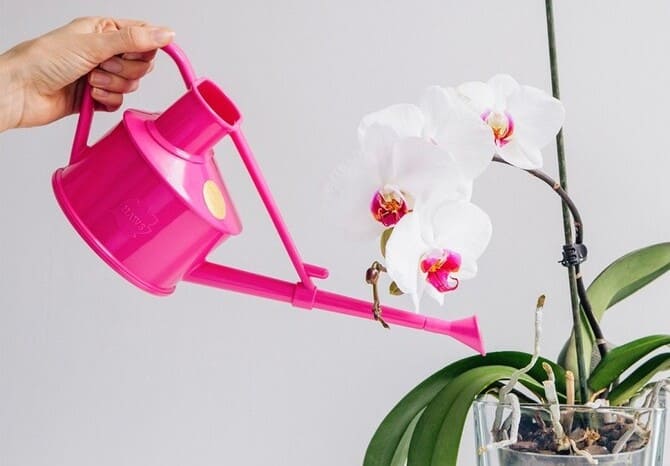
The orchid does not require frequent watering, but it should be abundant. The fact is that the frequent addition of water leads to the accumulation of moisture in the pot. And this is a direct road to the development of rot and the subsequent death of the flower.
At the same time, you need to water the plant abundantly so that the orchid gets drunk to its fullest. From a lack of moisture, the growth of the orchid will slow down and flowering will become scarce.
How often you water it is directly dependent on 2 factors: the season and the phase of plant development.
In winter, you need to water the orchid no more than 2-3 times a month. In summer, watering is carried out more often - every 3-4 days, plus it is additionally necessary to increase the humidity of the air. For example, using a saucer filled with water placed next to the orchid.
Watering at home
The frequency of watering directly depends on the variety of the plant, as well as the conditions of its maintenance. Conditions under which watering is different:
- soil composition;
- temperature regime (season);
- Times of Day;
- illumination level;
- the physiological state of the flower (dormancy or active growth).
Florists need to take these factors into account, since temperature drops are always accompanied by changes in humidity levels.
Sprinkling (shower)
This method is often used when watering orchids. This is due to its similarity to the effect that tropical rains create. Its use promotes the growth of leaves, which has a beneficial effect on flowering. Regular rinsing of the leaves is also helpful to prevent pests.
This watering method is as follows:
- Transfer the plant to the bathroom and gently watered with a weak stream of water using a shower head. The water temperature should be + 40 ... + 52 degrees.The duration of irrigation is not defined as it depends on the time the soil is absorbed.
- Excess liquid from the soil should drain. To do this, leave the flower in the bath for a while.
- Remove excess liquid from the sinuses and leaves with a soft cloth. Ignoring this recommendation leads to rotting of the core and, as a result, lack of growth.
Attention! This irrigation method is recommended for apartment owners only. This is due to the hardness of the water: it is soft in the water pipes.
Immersion
This watering method is as follows:
- Immerse the flower pot in water so that the water covers the entire soil.
- Remove it from the water, let the excess liquid drain. If the plant has been in water for 20 seconds, the same time is required for the soil to dry out.
- Remove excess liquid from the sinuses and leaves with a napkin.
When using this method, it is important to avoid over-wetting the substrate. It can only be used for orchids that have no signs of disease.
Watering with a watering can
For watering in this way, you will need a watering can:
- Water the entire area of the substrate in a thin stream so that water does not get into the axils of the leaves and the growth points of the flower.
- Stop watering when the water soaks all the soil and starts flowing out of the holes of the pot.
- Excess liquid from the soil should drain, after which the procedure should be repeated one more time.
- Finally, remove excess liquid from the leaves and sinuses.
Interesting! This method of watering is recommended until 12 noon.
Spraying
This irrigation method is good for plants that use blocks rather than soil to grow. This is due to the fact that their roots lose moisture very quickly, therefore, more frequent watering is needed.
Spraying Features:
- the maximum effect is achieved only if the atomizer is switched to a light haze mode;
- use settled water for the procedure;
- so that the root system has time to dry, spraying is recommended in the morning.
Peculiarity! The structure of the water does not affect the number of sprays, however, when using distilled water, the plant will be deprived of essential nutrients and trace elements. This will lead to the wilting of the flower and its death.
What should be the watering of a blooming phalaenopsis orchid?
The irrigation rule in this case does not differ from other periods, however, prolonged drying is contraindicated, since it will cause the fall of flower buds and buds.
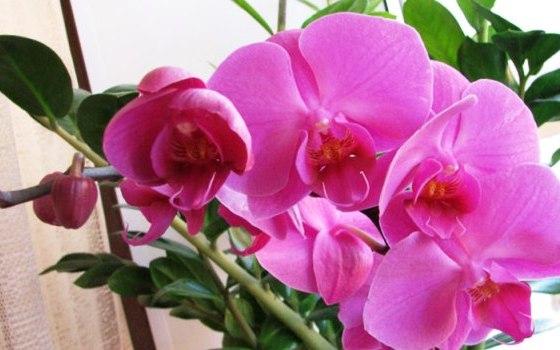
Despite being hygrophilous, Phalaenopsis and other representatives of orchids tolerate a lack of moisture more easily than an excess of it, leading to the development of root rot.
If you see that the substrate remains wet for several days, it should be changed to a soil with larger fractions, which provide better air permeability.
How to determine if the roots and substrate are already dry?
The soil intended for orchids dries out unevenly, especially if it consists of small fractions. The top layer on the surface is more exposed to the sun than the middle one, and therefore dries faster.
The same can be said about the lower layer of the substrate, when in winter the window sill under the orchid is heated by the battery. How can you determine that the phalaenopsis is ready for the next watering? We offer you 3 options for checking.
- Focus on the weight of the pot. Immediately after irrigation, take it in your hand and feel how heavy it is. Do the same after a few days. If you feel that it has become much lighter, it may be time to water.
- You can stick a wooden stick in the middle of the pot and, before watering the phalaenopsis, take it out and see if it is dry or not. If the inside of the pot is still damp, then refrain from watering.
- The condition of the substrate and roots can be assessed visually through a transparent pot. A wet substrate is darker in appearance than a dry one.Moisture-saturated roots of the plant are green, and dry roots are silvery, gray.
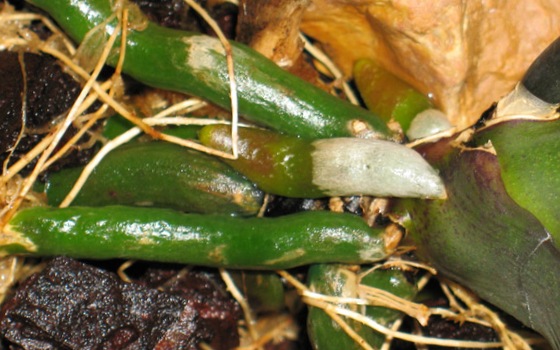 Wet roots of phalaenopsis
Wet roots of phalaenopsis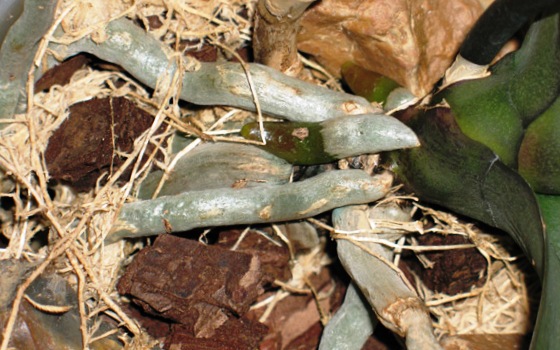 Phalaenopsis dry roots
Phalaenopsis dry roots
At first, you can use all 3 options so as not to be mistaken. And after your own long observations, you can choose the one that is most convenient for you, and accurately determine the watering time.
Irrigation nuances
We figured out the quality and type of water, now it's time to talk about the intensity of its use, depending on a number of factors.
During the setting of buds and flowering
Many home growers consider this time to be the main one, and intensively begin to irrigate their favorite flower. And this is a gross mistake.
During the laying of the flower buds themselves, watering the plants is carried out no more often than every other day, and even better once every 2 days. And at the same time, the temperature of its environment should be reduced to +8.12 degrees.
From the beginning of flowering, the azalea is watered regularly, but in moderation, only to saturate the substrate with moisture. The temperature at this time is raised to +16 degrees. Only the right ratio of watering and temperature regime will ensure long and intense flowering of azaleas.
The rest of the growing season of the flower, watering it is rare and moderate. About 1-2 times a week.
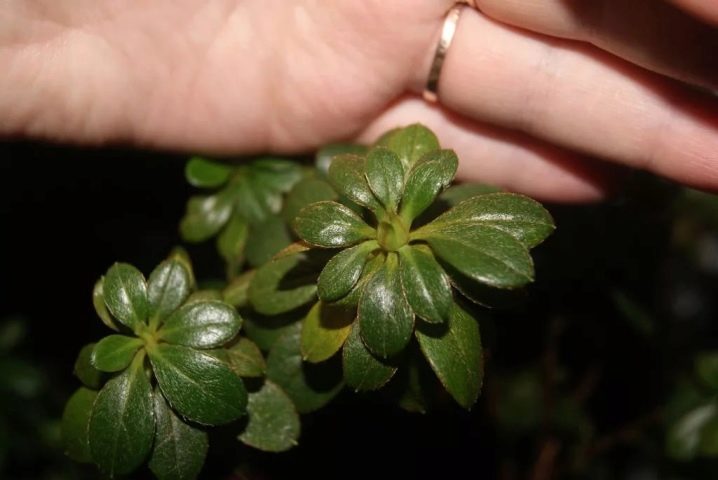
Depending on the season
In winter, watering azaleas is extremely rare, no more than 1 time per week. But this is subject to compliance and temperature conditions up to +8 degrees.
In spring and autumn, watering is carried out, relying on the period of budding and flowering. In summer, due to high temperatures and low humidity, watering becomes more abundant and regular - 2-5 times a week. In exceptional cases, the flower is watered daily.
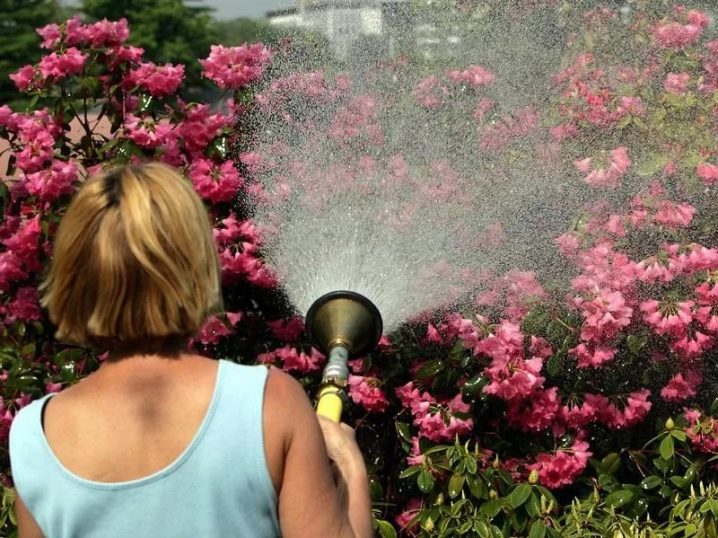
Depending on the place of growth of the plant
This factor must be taken into account, because it is almost impossible to artificially control the level of humidity and air temperature in a garden or on a personal plot. Therefore, the azalea growing in such conditions must be watered, based on the weather, the intensity of the rain and the place of its planting. The main criteria are the same - soil drying rate, plant development cycle and temperature.
Watering, its frequency and intensity of watering this flower in indoor growing conditions must be carried out, relying on all the rules above in the previous paragraphs.

Azalea transplant
The procedure should be performed at any time of the year, except for winter. That is, at that moment, while the plant does not bloom, and until its buds are formed. A young azalea is transplanted every year, an adult flower - once every 36 months.
The watering sequence for transplanting will be as follows:
- the plant is carefully removed from the pot and placed in a container with clean soft water;
- we add preparations designed to accelerate the growth of the root system and agents with an antifungal effect (we dilute them according to the instructions);
- we keep the flower in the resulting solution for at least 30 minutes and no more than 1 hour;
- then we plant the plant in a large new container with a light acidic soil and water it with the same solution in which the roots were soaked.
Within a month after transplanting, the flower is watered with a solution of water with growth stimulants. It is enough to dilute 1 g of succinic acid in a liter of liquid. Irrigation frequency is 1 time in 2 or even 3 days.
Experienced florists also recommend maintaining the room temperature at about 22 degrees above zero for the first time, and covering the roots of the flower with a cloth. After about a couple of weeks after the transplant, the tissue is removed, and the free space in the pot is laid with ice cubes. So moisture will flow in the right amount, and the cold, which is so necessary for the plant, will be present.
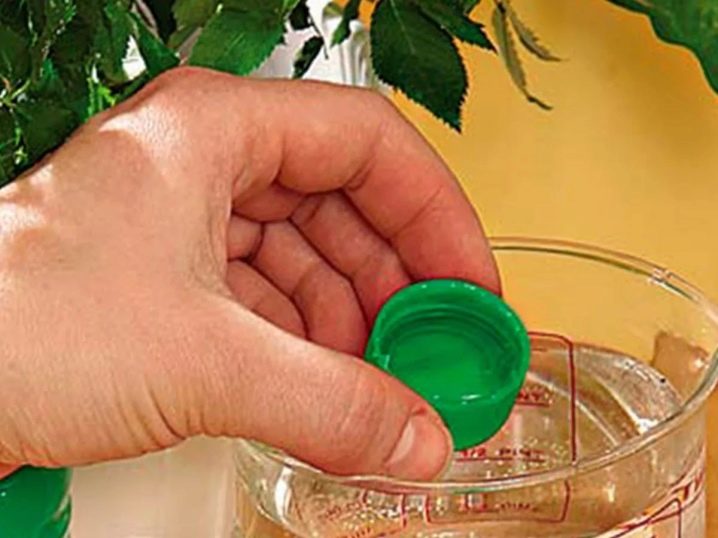
Is it necessary or not?
The transplanting process is always associated with damage and stress for any plant.For successful regeneration, orchids need sufficient air humidity (60-90%), which can be provided by spraying or using a special air humidifier, and a balanced amount of moisture in the soil.
In addition, when watering, the soil is compacted, as a result of which it is evenly distributed inside the pot between the roots of the plant. In the case of natural subsidence of the substrate after watering the potted orchid, it is necessary to add a small amount to the container, otherwise the soil may become insufficient.
Features of summer watering flowers
Despite the summer heat, these plants do not need abundant and frequent watering. In their natural environment, most of them belong to epiphytes, that is, they most often grow on trees and in depressions on rocks. That is why their root system is in a free state.
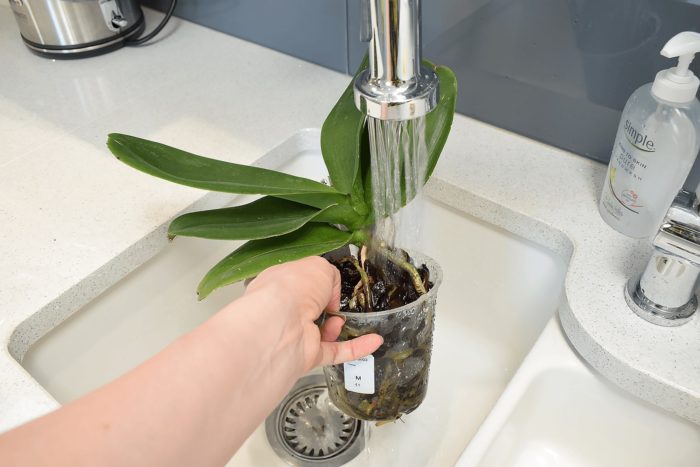
It is pointless to water the roots in any container. The ideal option is to provide them with conditions as close as possible to natural ones. In the summer, it is best to water the orchid with a shower: keep the flower for several minutes under a weak stream of water at room temperature. It is advisable to carry out this procedure once a week. To prevent root decay, wipe the remaining water at the core dry with a napkin.
Important! In the summer, the humidity is quite high, so a container of water can be left next to the orchid to maintain vital activity.
Watering methods
At home, the orchid is watered in several ways:
- top watering with a watering can;
- immersion method;
- warm shower;
- into the pallet.
Any of these methods are suitable for watering orchids during summer and winter.
Top watering
The most common traditional watering method for all indoor flowers is with a watering can. Prepared water must be carefully poured along the inner edge of the pot. As soon as water seeps into the pan, watering is stopped. For orchids from the pan, there is no need to pour water out, it will evaporate by itself or be absorbed into the substrate. The photo below shows an overhead watering of an orchid.
Top watering orchids photo
The peculiarity of indoor orchids is that they are planted not in the soil, but in organic soil, which consists mainly of pieces of wood, so the water cannot be evenly distributed inside the pot. The upper roots may suffer from drying out, and the lower ones - from excess moisture.
This can cause the flower to become dehydrated, causing the plant to wilt, the leaves to turn yellow, and then the orchid may die. More often this problem occurs in winter due to high humidity and insufficient lighting.
Immersion method
It is recommended to use such watering weekly; for this, the pot is placed in a basin of warm water for 15-20 minutes. When the substrate is completely saturated with moisture, the plant can be rearranged to its usual place. This irrigation method is used regardless of the stage of growth of the orchid, especially during the flowering period.
The photo shows "watering an orchid by immersion"
To better control the condition of the soil, it is recommended to use transparent pots for growing orchids.
The bottom should be high, when watering it is important not to overmoisten the root collar of the orchid, otherwise the plant may die from decay
Watering with a warm shower
For watering orchids, a warm shower is used, which resembles a tropical rain. Phalaenopsis feels comfortable after such a bath. Leaves are also cleaned from dirt and dust. For bathing in the shower, the plant is placed in a bathtub and a stream from the shower is directed to the leaves and stem. For 1-2 hours, the flower can be left in the bathroom, at this moment the most natural conditions are observed in which the orchid grows in nature.
The photo shows "Watering with a warm shower"
Before you put the flower pot in place, the remaining moisture on the leaves must be blotted with a napkin. Bathing frequency depends on humidity, temperature and season. In the summer, watering with a shower is done 2-3 times a month, in the cold season one is enough.
Pallet watering
This method of watering orchids is best for flowering plants. It is convenient for its simplicity and does not require much time. Before watering the orchid in this way, it is necessary to dilute the necessary top dressing in water and pour it into the pan.
Watering orchids in a pallet photo
The disadvantage of this method is that you need to occasionally wash the trays from salt deposits. Do not put several plants in one pallet to avoid contamination of healthy plants from diseased ones.
Having considered how to properly water an orchid at home, you can choose any method or alternate them.
Spraying orchids
When spraying, it is necessary to maintain a distance of 20-25 cm so that large drops of water do not collect on the flower, otherwise the leaves will become covered with spots and the flowers will fade. For this procedure, use settled or boiled warm water.
Phalaenopsis is sprayed only in summer, in winter the plant does not need it, moreover, during this period, the procedure can cause harm. It is recommended to spray at least once a day, while the spray gun should spray water in a light haze mode. The procedure is best done in the morning, so that the leaves dry until the evening, this is necessary in order to avoid the appearance of rotting leaves and growth points.
Spraying orchids photo
Some species, for example Miltonia, do not tolerate spraying. For this orchid, spraying soil in a pot is more suitable to avoid waterlogging.
It must be remembered that after purchasing a flower in a store, it is better not to water it for a while. The regime of keeping the orchid could be violated, so the substrate should dry out as much as possible.
Watering methods
There are several ways to water your orchid. Choose a method depending on the option of growing a flower. Regardless of the method chosen, the water should be properly prepared. A walkthrough looks something like this:
- it is best to moisten the soil with rainwater;
- in the absence of such an opportunity, use boiled;
- to remove impurities, salts, iron compounds, chlorine, water should be passed through a filter, having previously allowed it to settle;
- you can add oxalic acid to the container before watering, which will help soften the water, and peat will also help to do this.
Hot shower
This method helps to ensure quality flowering and an increase in green mass. The variant resembles the humidification that occurs in the natural environment, so the orchid "likes" it very much. Irrigation from the top also provides an opportunity to thoroughly clean the leaves, prevent pests and disease infestation.
It is recommended to water the flower with 38 ° C water. In rare situations, it is allowed to take a hotter one - 40-50 ° C. This method involves the use of running water, but only in cases where such irrigation is rarely done. The hot shower method is as follows:
- the plant with the pots is placed in the bath;
- turn on the shower with a light pressure and irrigate the orchid from above;
- the duration of the procedure will depend on the type of soil; watering is finished when the plant is completely saturated with moisture;
- after a shower, the plant is left for 30 minutes so that the water glass, since remaining in the pan, it can cause waterlogging and rotting of the root processes;
- the final step will be wiping the leaves to eliminate moisture stagnation in the sinuses.
If the water is too hard, then it is better to refuse from the shower, as salt accumulations may remain on the leaves. This is an undesirable phenomenon for flowers. To get rid of salt stains, it is recommended to use a citric acid solution that neutralizes the effect of salts.
In order not to harm the plant, it should be kept in the bathroom for about 30 minutes, since a sharp change in temperature can lead to freezing of the orchid. This irrigation method requires strict control.
Immersion
This option is suitable not only for saturation with moisture, but also for fertilization, if you first dilute the additives in water. The method involves immersing the plant in a container filled with water. In this case, the edge of the pots should be above the water level. The duration of the immersion depends on the size of the pot, as well as the development of the root system, while the time should not exceed 15 minutes. During this period, the roots will have time to be saturated with moisture.
After the end of the immersion, the orchid must be allowed to drain. Excess moisture is removed. This method of watering is considered the most economical and safest, since the stem and leaves do not get wet. To carry out such a procedure, it is worth making sure that the plant is absolutely healthy, since this method is unacceptable for sick and affected orchids.
In some situations, several pots of orchids are lowered into a common basin.
This must be done with caution, since if there is at least one diseased plant, there is a high risk of infecting the rest.
Leica
This method involves the use of a long-nosed watering can. In this way, it will be possible to ensure uniform watering without damaging the leaves and stems. The plant should be irrigated with a moderate stream until water begins to flow out of the drainage holes. It is necessary to do 2-3 passes, after each one remove excess water from the sump.
This method of watering has a significant plus - it excludes moisture from entering the sinuses, which prevents the process of stem and leaf rotting. To achieve maximum effect without harming the orchid, watering should be done in the early morning. This will allow moisture to be absorbed evenly throughout the day, and in the evening the plant will be able to "rest".
Root spraying
This option is relevant when growing plants on blocks, without a substrate. For potted plants, you can also use this method, but it must be combined with another, which will provide a greater saturation of the roots with moisture. For root spraying, you need a spray bottle. Irrigation must be carried out through a fine dropper in the "fog" mode.
This must be done until the roots turn green. With such watering, plant organs are safe, overflow is excluded. Among the disadvantages of this method, the need for daily irrigation is distinguished. This is due to the fact that the roots dry quickly without a substrate.
Rules for proper watering at home
The orchid has many individual care nuances that differ from most other plants. As for watering, there are several basic rules:
- The water must be allowed to stand for at least 2-3 hours.
- Watering must be plentiful, but moisture stagnation must also not be allowed.
- The green parts of the orchid must be kept dry.
- Do not forget about this type of humidification as spraying - it imitates tropical air.
- Water the flower strictly in the morning.
By following these recommendations, you will be able to avoid many problems associated with improper care.
Important! The regularity and correctness of soil moisture have a beneficial effect on the intensity and duration of flowering.
We take into account the nuances
Observing general recommendations, you can achieve the longevity of the orchid and its abundant growth and flowering at home. For example, spraying with water with hydrogen peroxide stimulates the growth of green mass, accelerates the flowering process, eliminates diseases, and also prevents them. But there are certain situations in which you need to apply an individual approach to the irrigation process.
Watering during flowering
A blooming orchid requires more moisture than when it is dormant. That is why during such a period it is not necessary to wait until the substrate is completely dry.When completely dry, a change in the color of the leaves can be observed, the flower becomes lethargic and lifeless, which negatively affects the bud. The plant should be irrigated several times a week. It is better if only the roots are in contact with moisture. Watering with a long-nosed watering can or root spraying is ideal.
In winter
In winter, the moisture requirement of an orchid is significantly lower than in other seasons. It is enough to water the plant about once every 2 weeks. The main thing is to monitor the drying of the roots.
Winter care should include temperature control. This is due to the fact that at temperatures below 18 ° C, the root system begins to absorb less moisture. To avoid freezing the roots, you can use foam coasters or special rugs.
Watering the plant also needs to be done carefully. After saturation of the roots with moisture, it is worth leaving the pot alone so that the excess water glass
This will prevent the plant from freezing when moving to a cooler windowsill (where flowers usually stand).
After the purchase
Watering after purchasing an orchid depends on the condition of the plant. First of all, it is worth assessing the condition of the root system. Often there is a peat cup in the flower pot, which helps to retain moisture at the base of the roots. It should be removed to avoid water stagnation and decay. When removing the cup, it is also necessary to remove rotten and dried roots, if any.
The purchased orchid should be isolated from other plants, and also slightly limited direct sun exposure to the flower. It is also not recommended to immediately feed. Temporary quarantine will allow you to determine the presence of diseases and get rid of pests in time. At the time of isolation, it is better to limit the plant in watering. But this only applies to dormant orchids.
If the plant to be purchased is in bloom, then it cannot be limited to watering. In such cases, the flower pot should be placed in a bright, warm room and provided with moderate irrigation until the roots have acquired the desired color. The most effective method of watering after purchase is immersion. It allows not only to saturate the plant with moisture, but also to wash out unwanted impurities from the substrate.
After transplant
The plant is transplanted most often immediately after acquisition or in the spring, when the flower comes out of hibernation. In addition to transplanting, the orchid may require root pruning and fertilizing. The substrate for the procedure is bought ready-made in a store or made by hand at home. In any case, it is very dry, which makes it possible to exclude the development of fungus.
That is why it is important to saturate the soil with moisture immediately after planting.
The immersion method is often used to water the transplanted orchid. The pot is immersed in warm water for 20 minutes. After the roots are saturated with water, excess moisture must be allowed to drain. After the procedure, the plant must be placed in a darkened place, since transplants are very stressful for the flower. The next irrigation should be done no earlier than 2 weeks later.
At the end of the adaptation process, the orchid should be watered up to 2-3 times a week. This applies to those cases when the transplant falls in the summer period and the moment of flowering.
When and how an orchid blooms
The flowering of orchids of different varieties occurs in different ways. Not only the appearance is different, but also the period (duration) of flowering. Depending on the species, orchids begin to bloom at the age of 1.5-3 years. If the age of the plant at the time of purchase is not reported, it is sufficient to count the number of shoots. 5-8 shoots are enough for age determination. Early flowering is not the most favorable sign. The reason is simple - the plant is still young. It is not worth waiting for the orchid to bloom after transplantation. There is a risk that it will not recover and will die after the first flowering.
Blooming white orchids
When the orchid blooms, the buds near the peduncle appear first.In just one day, the buds can fully open. After a few days, the flowers will begin to grow actively, after which a mature flower will appear. Depending on the type of plant, the color and shape of the flower may vary. Beautiful flowers, pleasant aromas, long flowering - for these reasons, many people like orchids.
Flowering period
With the right conditions and proper plant care, the flower will bloom and be eye-catching for several months. Most orchid species are pleasing to the eye 2-3 times a year. If the orchid is blooming, do not move it from place to place at home.
It's important to know! Long bloom is the main sign that the surrounding conditions are suitable for the flower. The process also depends on the age of the plant.
The emergence of flowers
Pedicels tend to grow in the strangest ways. She can bend into a braid, then begin to grow in an arbitrary direction. When the blooming buds of indoor orchids sprout, the owners should have minimal impact on them. The plant should not be transplanted under any circumstances. Pedicels always begin development from the point of growth.
It is not difficult for an experienced grower to distinguish a bud from a root. A person without experience cannot always immediately determine which part of the plant is in front of him and how much the orchid blooms. After a short rest, indoor flowers grow for a long time. The beginning of autumn is the most favorable period for new buds. This rule applies primarily to the phalaenopsis species.
The appearance of the pedicel
Among orchids of the phalaenopsis species, new leaves appear most often in summer or early autumn, and inflorescence stems are formed in late autumn. The long-stemmed buds of a large flower orchid are famous for their massive flowers and can be formed by cutting. During flowering, these plants should be placed in a uniform, moist substrate.


